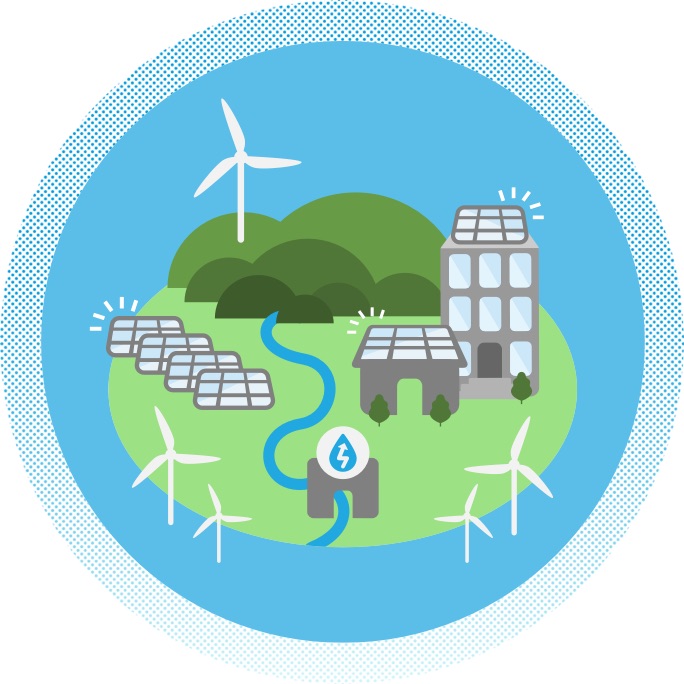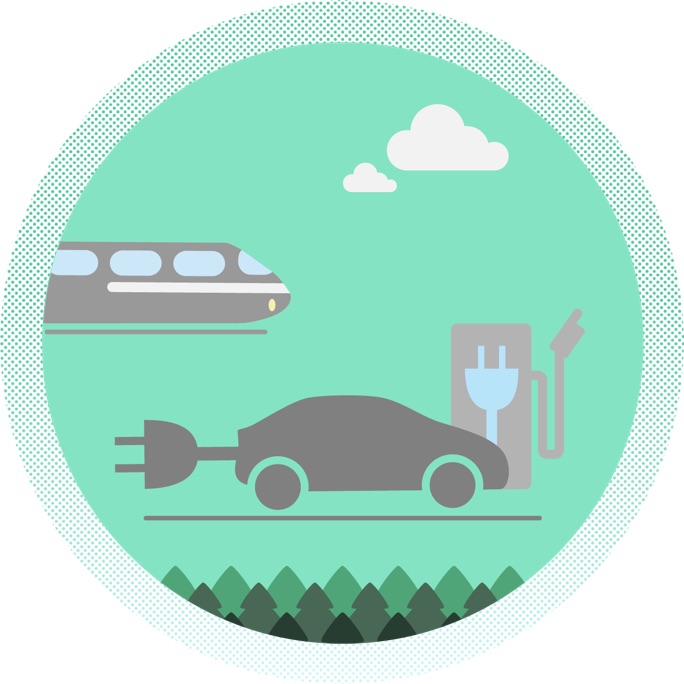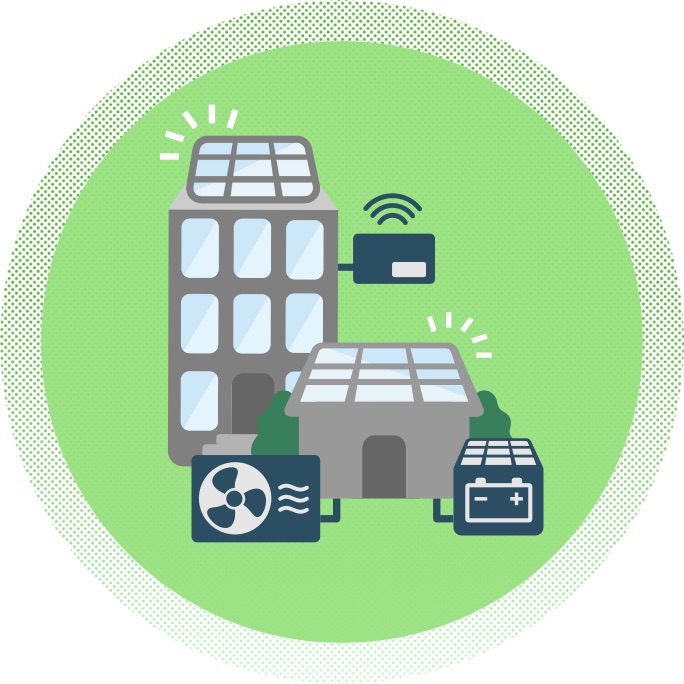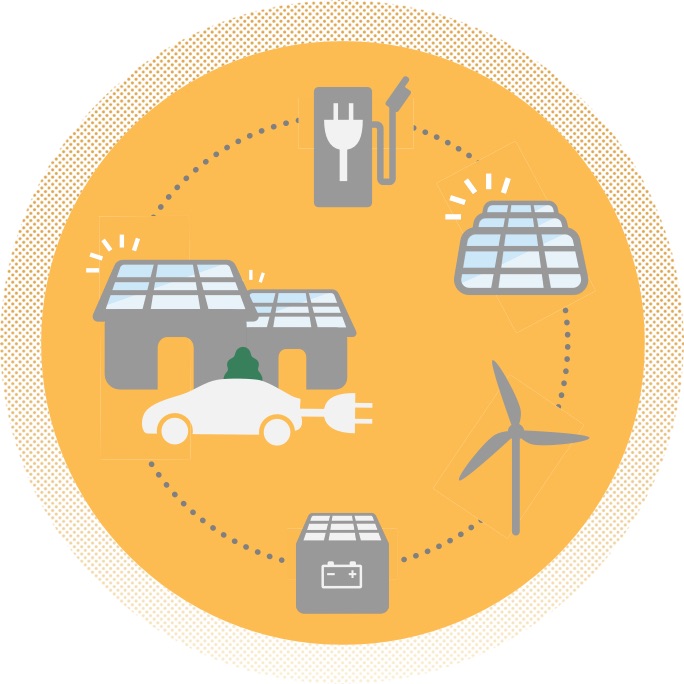from 1990 levels
A Modern System Reduces Emissions
EnergyVision 2030 recommends a path to meet emissions reduction goals by using market-ready technologies to build a cleaner, more modern energy system. The scientific community agrees that we must cut emissions 80% from 1990 to 2050 to avoid the worst effects of climate change. To meet this target, states in the Northeast should reduce emissions 45% by 2030 to be on a straight trajectory.
Solutions in Four Key Areas
Clean energy technologies can modernize the grid, generate electricity, efficiently heat and cool buildings, and transport people and goods. These technologies are the keys to a future that is modern, healthy, and low-carbon. Learn more about how each area contributes to EnergyVision 2030 by clicking the buttons below.
Electric Generation
Our electricity must come from increasingly clean sources. As renewable energy displaces high-carbon fossil fuel generation, cleaner electricity can replace petroleum and natural gas in transportation and heating by fueling electric vehicles and heat pumps. To move to a low-carbon system, states can advance grid-scale renewables, promote clean distributed generation, and strengthen market-based emissions policies.
Read More
Transportation
Transportation is the largest source of emissions in the Northeast and traditionally the most difficult emissions sector to address, but rapidly evolving technology offers deep reduction potential. Electric vehicles (EVs) and innovations in mobility options can help improve transportation efficiency and reduce emissions. The improved transportation system will promote vibrant rural and urban communities.
Read More
Buildings
Buildings offer significant energy efficiency investment opportunities that can be combined with clean heating technologies to provide deep emissions reductions. Efficiency improvements—like home insulation and LED lighting—significantly reduce energy use, complement the adoption of advanced technologies, and make buildings more comfortable and affordable to heat and cool.
Read More
Grid Modernization
To advance the clean energy future, we must create a modern, low-carbon energy grid. This system will be fair and safe, protecting consumers and allowing clean energy to flourish. Using new technologies, the grid will give consumers more control over their energy. To make this shift, the states must update grid rules to reward utilities that seek to modernize.
Read More
A Future that Benefits All
A modern, low-emissions energy system benefits the people who use it. By 2030, residents of New York and New England will have more choice and control over their energy and fewer health problems resulting from greenhouse gas emissions.
Community-Centric Systems
A modern energy system benefits our communities. Local, small-scale energy projects, like distributed community solar, give communities the power to choose the energy mix best for them. Community energy offers residents, local businesses, and municipal governments unprecedented access to affordable, local energy for all residents and expands local job opportunities.
Improved Public Health
A modern energy system will give all consumers greater control over their energy and environment. This control will allow them to make choices that can improve their families' health while contributing to a system that will improve health globally. Recent studies show that emissions reductions in northeastern and mid-Atlantic states have saved hundreds of lives and tens of thousands of dollars in health benefits since 2009.
Empowered Consumers
An efficient, modern system is a transparent system that gives consumers the information and resources they need to make smart choices. Consumers can benefit directly from clean energy in their own homes (for instance, by using clean technologies to generate or store electricity or to maximize savings) and from the impacts the new energy system will have on society at large.
A Region Ready for Change
EnergyVision 2030 explores how using more clean energy technologies can benefit a seven-state region that includes New York, Connecticut, Maine, Massachusetts, New Hampshire, Rhode Island, and Vermont.
New York
New York has undertaken ambitious reforms toward the clean energy future. The state has committed to modernize its grid and dramatically increase renewables in its energy mix.


New England
Many New England states have shown their commitment to clean energy through nation-leading energy efficiency programs and renewable energy installations.


Northeast
The Northeast region is proving the benefits of working together through programs like the Regional Greenhouse Gas Initiative to ensure that our future energy system empowers all consumers and reduces emissions.


How EnergyVision 2030 Works
EnergyVision 2030 is a data-based analysis that uses the Long-range Energy Alternatives Planning System (LEAP) model from Stockholm Environment Institute to project a detailed forecast of energy consumption in all sectors and an emissions trajectory. Acadia Center incorporated the U.S. Energy Information Administration (EIA) Annual Energy Outlook (AEO) forecast, the New England and New York Independent System Operators’ forecasts, and other data sources as appropriate. The LEAP model contains an electric dispatch model to simulate the electric system, determine the generation mix and ensure that there are sufficient resources to satisfy peak demand for power in summer and winter.
Get More Materials
Download EnergyVision 2030 companion materials, including a summary brochure and poster, companion briefs on each region and key area, and the technical appendix.
View Materials